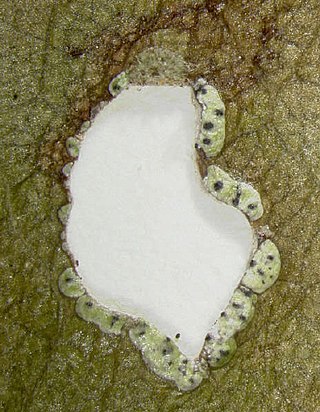
Pier Andrea Saccardo was an Italian botanist and mycologist. He was also the author of a color classification system that he called Chromotaxia. He was elected to the Linnean Society in 1916 as a foreign member. His multi-volume Sylloge Fungorum was one of the first attempts to produce a comprehensive treatise on the fungi which made use of the spore-bearing structures for classification.

The Physalacriaceae are a family of fungi in the order Agaricales. Species in the family have a widespread distribution, ranging from the Arctic, (Rhizomarasmius), to the tropics, e.g. Gloiocephala, and from marine sites (Mycaureola) and fresh waters (Gloiocephala) to semiarid forests (Xerula).

Oudemansiella australis is a species of gilled mushroom in the family Physalacriaceae. It is found in Australasia, where it grows on rotting wood. It produces fruit bodies that are white, with caps up to 5.5 cm (2.2 in) in diameter, attached to short, thick stems.
Cucujomyces is a genus of fungi in the family Laboulbeniaceae. The genus contain 14 species.
Ophiosphaerella is a genus of fungi in the family Phaeosphaeriaceae. The genus was described by Italian-Argentinian botanist and mycologist Carlos Luigi Spegazzini in 1909.
Lindquistomyces is a fungal genus in the family Amphisphaeriaceae. This is a monotypic genus, containing the single species Lindquistomyces antarcticus. This species was originally described as Ophiobolus antarcticus by Carlos Luigi Spegazzini in 1887.
Roumegueriella is a genus of fungi in the class Sordariomycetes. It consists of three species.
Dubitatio is a fungal genus in the family Massariaceae. According to the 2007 Outline of Ascomycota, the placement of the genus in this family is uncertain. This is a monotypic genus, containing the single species Dubitatio dubitationum, found in temperate South America.
Rostafinskia is a genus of fungi in the Ascomycota phylum. The relationship of this taxon to other taxa within the phylum is unknown, and it has not yet been placed with certainty into any class, order, or family.
Schweinitziella is a genus of fungi in the family Trichosphaeriaceae.

Carlo Luigi Spegazzini, in Spanish Carlos Luis Spegazzini, was an Italian-born Argentinian botanist and mycologist.

Holwaya is a genus of fungi in the family Bulgariaceae. Holwaya is monotypic, containing the single species Holwaya mucida, which was originally named Bulgaria ophiobolus by Job Bicknell Ellis in 1883, and later transferred to the newly created Holwaya by Pier Andrea Saccardo in 1889. The genus name of Holwaya is in honour of Edward Willet Dorland Holway (1853-1923), who was an American botanist (Mycology) and Banker.

Oudemansiella mucida, commonly known as porcelain fungus, is a basidiomycete fungus of the family Physalacriaceae and native to Europe.
Ponticulomyces is a genus of fungi in the family Physalacriaceae. The genus was described by American mycologist Ron Petersen in 2010. It includes the type species Ponticulomyces kedrovayae, known from Pacific maritime Russia, and the Chinese species P. orientalis, originally described as a member of Oudemansiella in 2000. Both species were reported from Japan in 2012. The generic name, which derives from ponticulus, and myces ("fungus"), suggests a bridge between taxonomic characters common to the genera Oudemansiella and Hymenopellis.
Protoxerula is a fungal genus in the family Physalacriaceae. Described in 2010 by American mycologist Ron Petersen, the genus is monotypic, containing the sole species Protoxerula flavo-olivacea. This species was originally described as a Xerula in 2008 and transferred to Oudemansiella the following year before the new genus was circumscribed to accommodate it. P. flavo-olivacea is known from northeastern Australia, where it fruits singly to scattered in undisturbed rainforest, usually near plants from the genera Acacia, Agathis, and Corymbia. The variety kimberleyana, named for its type locality in the Kimberley region of Western Australia, has a greenish-cream cap colour, gills that become white and readily crumble when dry, long pseudorhiza with a hairy surface, ellipsoid basidiospores, thick-walled "hairs" (setae) on the cap surface, and a unique capitulate ("head-like") pleurocystidia.
Lentinula guarapiensis is a species of agaric fungus in the family Omphalotaceae that is found in Paraguay. Originally described by Carlos Luigi Spegazzini in 1883 as Agaricus guarapiensis, it was moved to the genus Lentinula by David Pegler in 1983. It is only known from the type collection.
Paraxerula is a genus of fungi in the family Physalacriaceae. It was circumscribed in 2010 by mycologist Ron Petersen to replace Xerula section Hyalosetae, proposed by Heinrich Dörfelt in 1984. Petersen originally included P. caussei, P. hongoi, and the type species P. americana. The Chinese species P. ellipsospora was added to the genus in 2014.

Strigulaceae is a family of lichen-forming fungi, one of two families in the order Strigulales. Recent (2020) molecular analysis of the type genus, Strigula, has led to a reallocation of the foliicolous species into six genera that correspond to well-delimited clades with diagnostic phenotype features.
Libertiella is a genus of fungi belonging to the family Pilocarpaceae.

Corneille Antoine Jean Abram Oudemans or Cornelis Antoon Jan Abraham Oudemans was a Dutch botanist and physician who specialized in fungal systematics.









